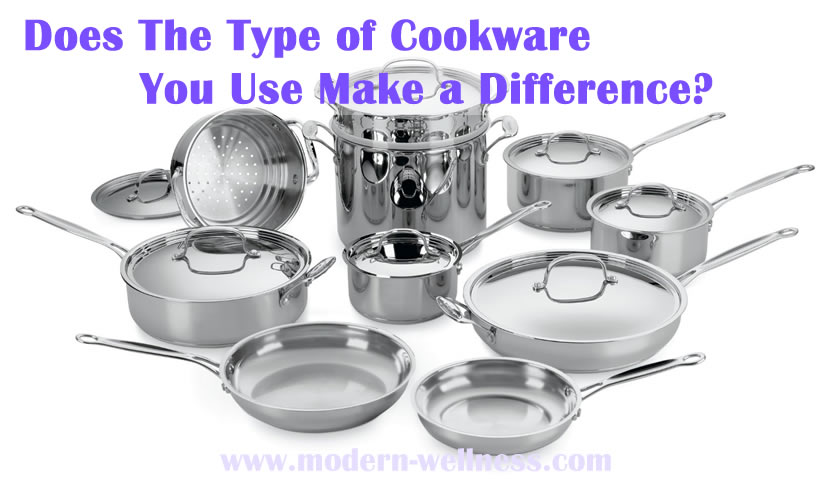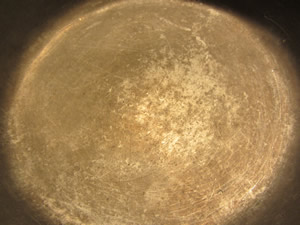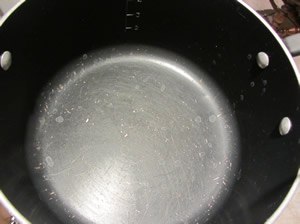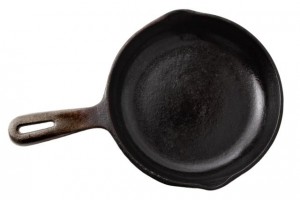Cookware… Does It Make A Difference?

On our journey to a more natural lifestyle I couldn’t help but think that the black stuff on the lining of my pans, that was coming off, couldn’t be good for my family. I hate to admit it, but after doing some research I found out that we’ve had horrible cookware in our home our whole marriage. We were given a nice set of stainless steel when we were first married but it seemed like everything stuck to it (I just didn’t know how to cook), so we gave it away. I would like to kick myself for that now.
So let’s talk about why we want to be careful with the kind of pots and pans we use in our homes.
Aluminum
 More than half of cookware sold today is made of aluminum. I don’t care for those odds. Aluminum has been linked to Alzheimer’s disease and impaired visual motor coordination. If I’m using this pot on a daily basis I can’t feel safe knowing that there is a possibility that the aluminum is leaching into the food I’m cooking. You can see that the pot in the image is very worn and has lots of pits! I’m almost certain that it has been leaching crud into our food…not a happy thought. Good thing Cilantro is so amazing! 🙂
More than half of cookware sold today is made of aluminum. I don’t care for those odds. Aluminum has been linked to Alzheimer’s disease and impaired visual motor coordination. If I’m using this pot on a daily basis I can’t feel safe knowing that there is a possibility that the aluminum is leaching into the food I’m cooking. You can see that the pot in the image is very worn and has lots of pits! I’m almost certain that it has been leaching crud into our food…not a happy thought. Good thing Cilantro is so amazing! 🙂
If you have aluminum cookware you want to make sure:
- That it is in good condition. The more beat up and pitted it is, the the greater the likelihood that it’s leaching into your food.
- That you don’t store your food in it for long periods of time.
- You don’t cook highly acidic food in it such as tomato sauce, rhubarb, or sauerkraut in it. The acid may cause more aluminum to enter the food.
You can get anodized aluminum that has been treated to develop a hard non-reactive coating on the surface of the cookware. Commercial Aluminum Company claims that a final stage in the anodization process seals the aluminum preventing it from leaching into your food.
One positive side to aluminum cookware is that it has really good heat conduction, which means it spreads the heat evenly.
Teflon
 Teflon and other non-stick finishes scratch very easily! I have proof (see photo). When the surface gets scratched, especially while it is being cooked with, little pieces of coating are released into the food. Gross!
Teflon and other non-stick finishes scratch very easily! I have proof (see photo). When the surface gets scratched, especially while it is being cooked with, little pieces of coating are released into the food. Gross!
DuPont studies have shown that when Teflon is heated to 446ºF it releases toxic particulates. At 680ºF Teflon pans release at least six toxic gases, including two carcinogens.
The Environmental Working Group conducted a study in 2005 that found the Teflon chemical PFOA in the cord blood of US-born infants. John Hopkins Hospital also did a similar study and found that out of 300 newborns that were tested, 99% of them had PFOA in their umbilical cord blood!! I hate to think that my kids were born with it in their systems. 🙁
If you have Teflon you’ll want to:
- Consider replacing it!
- Don’t overheat it. I have unfortunately done this very thing! I left a pan of boiling water on the stove and forgot about it. Looking back on it, I can’t imagine how much garbage I put into the air my family was breathing.
- Keep pet birds away. Apparently, the fumes from Teflon are particularly harmful to birds.
Cast Iron
 We would have loved to purchase cast iron but we are trying to move later this year and didn’t want to have to pay to ship these pans to Hawaii. We do have one cast iron pan. I haven’t used it much over the years but I think I’ll pull it out and make sure it’s more easily accessible.
We would have loved to purchase cast iron but we are trying to move later this year and didn’t want to have to pay to ship these pans to Hawaii. We do have one cast iron pan. I haven’t used it much over the years but I think I’ll pull it out and make sure it’s more easily accessible.
Cast iron has an unparalleled even heat capacity. The downside is that it takes a lot more energy to heat up these pans because they are so thick and dense. Cooking with cast iron inevitably puts iron into your food, which is a much-needed nutrient.
A couple of things to know about cast iron:
- You’ll want to make sure to keep your pans well seasoned (or coated). To do this you’ll heat up the pan and put unsalted cooking oil in the pag. Rub it around (I usually use a paper towel) so there is a good coating of it all over the pan. It is good to season your pan after each use…especially in the beginning when they are new.
- You don’t want to wash your pan with a strong detergent or a scouring pad. Once it is washed you also want to make sure to dry it immediately after rinsing.
Cast iron is a great option!
Stainless Steel
A while back I polled our Facebook group and there was a huge recommendation for stainless steel cookware. Many recommended the brand, All Clad. While I would have loved to get an All Clad set it just wasn’t in the budget…pretty steep prices!
Stainless steel is a corrosion resistant steel that is very hard wearing, easy to clean, and beautiful! The downside of stainless steel is that it is very poor at conducting heat. It’s important that if you choose stainless steel that you choose one that has an aluminum or copper core. Without an aluminum or copper core you will find that you get hot spots which will cook your food unevenly. That certainly takes the fun out of cooking!
You’ll want to:
- Avoid using abrasive materials when cleaning your stainless steel cookware. If you use an abrasive material it can release small amounts of chromium and nickel…and takes away the beautiful finish.
- Again, make sure that you buy pans with an aluminum or copper core.
What Did We Choose?
It certainly wasn’t aluminum or Teflon…that’s what we’re trying to get rid of. 🙂 Like I mentioned, cast iron was a great option but we went with a Stainless Steel set that has an aluminum core. We looked at several sets and after reading lots of reviews we settled on the Cuisinart 77-17 Chef’s Classic Stainless 17-Piece Cookware Set. Not only is it a great set, we got a GREAT deal! It is normally priced at $670! We got it for only $209. When they showed up yesterday I couldn’t wait to break into the box and try them out. I’m not a chef by any means…but my husband is, so I’ll wait to tell you how they work when he is able to use them. Haha!
4 thoughts on “Cookware… Does It Make A Difference?”
You must be logged in to post a comment.


What about ceramic? There’s a few brands pushing it at the moment here in Australia.
It honestly depends on what type of glaze the company uses. You will want to research the company in depth and see if they say that their glaze is non-toxic, etc… Good Luck!
I just wanted to know whether this stainless steel set doesn’t go brown or burnt color on many uses?
We have had our set for almost one year and they are not brown or burnt. Once in a while something we cook will leave a few brown spots but they have always just come off after one or two washings.